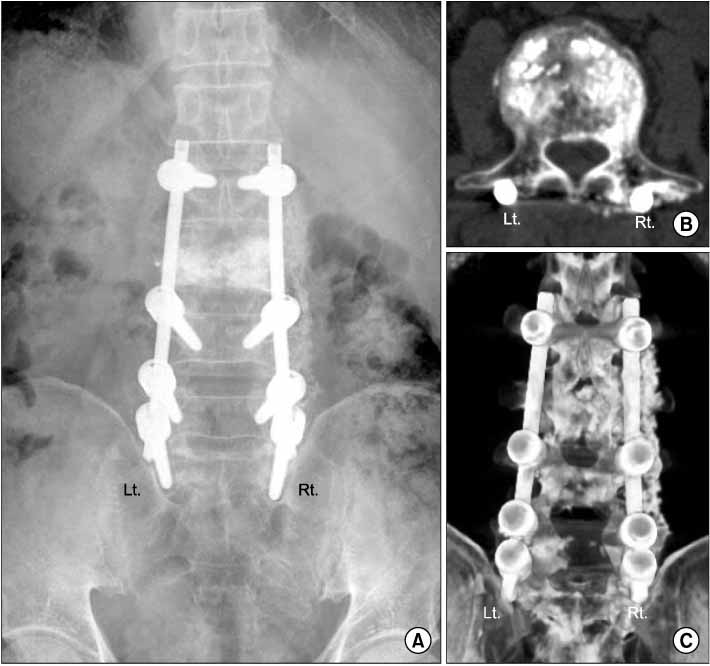J Korean Orthop Assoc.
2008 Jun;43(3):347-352. 10.4055/jkoa.2008.43.3.347.
Comparison of the Effect of Hydroxyapatite and Allogenous Bone as an Adjunct to Autogenous Iliac Bone Grafting in Posterolateral Spinal Fusion
- Affiliations
-
- 1Department of Orthopaedic Surgery, Hanyang University College of Medicine, Korea.
- 2Department of Orthopaedic Surgery, Guri Hospital, Hanyang University College of Medicine, Korea. hyparkys@hanyang.ac.kr
- KMID: 2186451
- DOI: http://doi.org/10.4055/jkoa.2008.43.3.347
Abstract
-
PURPOSE: We wanted to analyze the efficacy of hydroxyapatite as a bone graft extender and we wanted to compare the bone fusion rate between hydroxyapatite and allogenous bone as an adjunct to autogenous iliac bone graft in posterolateral spinal fusion.
MATERIALS AND METHODS
Our study included 19 patients who were treated with decompression and posterolateral spinal fusion using hydroxyapatite on right side and frozen allogenous bone on left side as an adjunct to autogenous iliac bone graft, and all the procedures were performed between May 2003 and August 2004. Fusion was determined by the final radiographic findings with using Christiansen's classification.
RESULTS
There were 3 male and 16 female patients. Their average age was 65.5 years (range: 48-81) and the average follow-up period was 21.5 months (range: 12-36). Fusion was performed in 3.4 segments (range: 2-6) on average per patient. Of all the 65 segments that underwent fusion, 63 segments (96.9%) in group using hydroxyapatite and 54 segments (83.1%) in group using allogenous bone were determined to be fused, and the difference was not statistically significant (p=0.074).
CONCLUSION
Hydroxyapatite as adjunct to autogenous iliac bone for use in posterolateral spinal fusion showed a high fusion rate and it seemed to be useful as a bone graft extender for reducing the volume of the autogenous iliac bone.
MeSH Terms
Figure
Cited by 1 articles
-
The Effect of Teriparatide in Women with Osteoporosis after Lumbar Posterolateral Fusion or Posterior Lumbar Interbody Fusion
Jeong Ho Seo, Kyu Yeol Lee, Min-Woo Kim
J Korean Soc Spine Surg. 2015;22(3):82-82. doi: 10.4184/jkss.2015.22.3.82.
Reference
-
1. An HS, Lynch K, Toth J. Prospective comparison of autograft vs. allograft for adult posterolateral lumbar spine fusion: differences among freeze-dried, frozen, and mixed grafts. J Spinal Disord. 1995. 8:131–135.2. Arrington ED, Smith WJ, Cambers HG, Bucknell AL, Davino NA. Complications of iliac crest bone graft harvesting. Clin Orthop Relat Res. 1996. 329:300–309.
Article3. Banwart JC, Asher MA, Hassanein RS. Iliac crest bone graft harvest donor site morbidity A statistical evaluation. Spine. 1995. 20:1055–1060.4. Boden SD, Martin GJ Jr, Morone M, Ugbo JL, Titus L, Hutton WC. The use of coralline hydroxyapatite with bone marrow, autogenous bone graft, or osteoinductive bone protein extract for posterolateral lumbar spine fusion. Spine. 1999. 24:320–327.
Article5. Bucholz RW, Carlton A, Holmes R. Interporous hydroxyapatite as a bone graft substitute in tibial plateau fractures. Clin Orthop Relat Res. 1989. 240:53–62.
Article6. Christensen FB, Laursen M, Gelineck J, Eiskjaer SP, Thomsen K, Bünger CE. Interobserver and intraobserver agreement of radiograph interpretation with and without pedicle screw implants: the need for a detailed classification system in posterolateral spinal fusion. Spine. 2001. 26:538–543.7. Ehrler DM, Vaccaro AR. The use of allograft bone in lumbar spine surgery. Clin Orthop Relat Res. 2000. 371:38–45.
Article8. Finkemeier CG. Bone-grafting and bone-graft substitutes. J Bone Joint Surg Am. 2002. 84:454–464.
Article9. Gibson S, McLeod I, Wardlaw D, Urbaniak S. Allograft versus autograft in instrumented posteolateral lumbar spinal fusion: a randomized control trial. Spine. 2002. 27:1599–1603.10. Korovessis P, Koureas G, Zacharatos S, Papazisis Z, Lambiris E. Correlative radiological, self-assessment and clinical analysis of evolution in instrumented dorsal and lateral fusion for degenerative lumbar spine disease. Autograft versus coralline hydroxyapatite. Eur Spine J. 2005. 14:630–638.
Article11. Kurz LT, Garfin SR, Booth RE Jr. Harvesting autogenous iliac bone grafts. A review of complications and techniques. Spine. 1989. 14:1324–1331.12. Louis-Ugbo J, Murakami H, Kim HS, Minamide A, Boden SD. Evidence of osteoinduction by grafton demineralized bone matrix in nonhuman primate spinal fusion. Spine. 2004. 29:360–366.
Article13. Sartoris DJ, Gershuni DH, Akeson WH, Holmes RE, Resntck D. Coralline hydroxyapatite bone graft substitutes: preliminary report of radiographic evaluation. Radiology. 1986. 159:133–137.
Article14. Thalgott JS, Fritts K, Timlin M, Giuffre JM. Anterior interbody fusion of the cervical spine with coralline hydroxyapatite. Spine. 1999. 24:1295–1299.
Article15. Thalgott JS, Fritts K, Timlin M, Giuffre JM. The use of coralline hydroxyapatite for interbody spinal fusions. Spine State Art Reviews. 1997. 11:325–339.16. Thalgott JS, Giuffre JM, Fritts K, Timlin M, Klezl Z. Instrumented posterolateral lumbar fusion using coralline hydroxyapatite with or without demineralized bone matrix, as an adjunct to autologous bone. Spine. 2001. 1:131–137.
Article17. Younger EM, Chapman MW. Morbidity at bone graft donor sites. J Orthop Trauma. 1989. 3:192–195.
Article
- Full Text Links
- Actions
-
Cited
- CITED
-
- Close
- Share
- Similar articles
-
- Local Bone versus Autogenous Iliac Bone Graft for Posterolateral Lumbar Fusion in the Same Patient
- Comparison Between Allograft Mixed with Local Bone and Autograft in Posterolateral Lumbar Fusion
- Lumbar Posterolateral Fusion Using Demineralized Bone Matrix
- Union Rates of Autologous Bone Marrow, Local Autobone and Biphasic Calcium Phosphate Mixed Graft in Lumbar Posterolateral Fusion
- Union Patterns of Local Autogenous Bone Grafts Using Metal Cages, Allogenic Bone, and Local Autogenous Bone Around the Cages During Posterior Lumbar Interbody Fusion: A Retrospective CT Analysis


